Beneficial Analysis of the Effect of Precipitation Enhancement on Highland Barley Production on the Tibetan Plateau Under Different Climate Conditions
Abstract
1. Introduction
2. Materials and Methods
2.1. Study Area
2.2. Data Collection and Processing
2.3. Description of the WOFOST Model
2.4. Calculation of SPEI
2.5. Beneficial Analysis
2.6. Statistical Analysis
3. Results
3.1. Calibration and Validation of the WOFOST Model
3.2. Analysis of Drought Conditions by SPEI Index
3.3. Effect of Precipitation Enhancement on Highland Barley Yields Under Different Drought Conditions
3.4. Spatial Distribution of Yield Increase Under Different Precipitation Enhancement Scenarios
3.5. Analysis of the Economic Benefits of Precipitation Enhancement
3.6. Preliminary Analysis of the Benefits of Precipitation Enhancement Under Climate Change Conditions
4. Discussion
4.1. Reliability of the WOFOST Model for Simulation of the Highland Barley Yields over the Tibetan Plateau
4.2. Complex Effects of Precipitation Enhancement Under Different Drought Conditions
4.3. Impact of Precipitation Enhancement at Different Growth Stages
4.4. Uncertainties and Future Research
5. Conclusions
Author Contributions
Funding
Data Availability Statement
Acknowledgments
Conflicts of Interest
References
- Chen, F.H.; Dong, G.H.; Zhang, D.J.; Liu, X.Y.; Jia, X.; An, C.B.; Jones, M.K.; Ma, M.M.; Xie, Y.W.; Barton, L.; et al. Agriculture facilitated permanent human occupation of the Tibetan Plateau after 3600 BP. Science 2015, 347, 248–250. [Google Scholar] [CrossRef] [PubMed]
- Zeng, X.; Long, H.; Wang, Z.; Zhao, S.; Tang, Y.; Huang, Z.; Tashi, N.; Wang, Y.; Xu, Q.; Mao, L.; et al. The draft genome of Tibetan hulless barley reveals adaptive patterns to the high stressful Tibetan Plateau. Proc. Natl. Acad. Sci. USA 2015, 112, 1095–1100. [Google Scholar] [CrossRef] [PubMed]
- Liu, Z.F.; Yao, Z.J.; Yu, C.Q.; Zhong, Z.M. Assessing crop water demand and deficit for the growth of spring highland barley in Tibet, China. J. Integr. Agric. 2013, 12, 541–551. [Google Scholar] [CrossRef]
- Bigolin, T.; Talamini, E. Impacts of climate change scenarios on the corn and soybean double-cropping system in Brazil. Climate 2024, 12, 42. [Google Scholar] [CrossRef]
- Dong, X.; Zhao, C.; Huang, Z.; Mai, R.; Lv, F.; Xue, X.; Zhang, X.; Hou, S.; Yang, Y.; Sun, Y. Increase of precipitation by cloud seeding observed from a case study in November 2020 over Shijiazhuang, China. Atmos. Res. 2021, 262, 105766. [Google Scholar] [CrossRef]
- Schaefer, V.J. The production of ice crystals in a cloud of supercooled water droplets. Science 1946, 104, 457–459. [Google Scholar] [CrossRef]
- Vonnegut, B. The nucleation of ice formation by silver iodide. J. Appl. Phys. 1947, 18, 593–595. [Google Scholar] [CrossRef]
- Flossmann, A.I.; Manton, M.; Abshaev, A.; Bruintjes, R.; Murakami, M.; Prabhakaran, T.; Yao, Z. Review of advances in precipitation enhancement research. Bull. Am. Meteorol. Soc. 2019, 100, 1465–1480. [Google Scholar] [CrossRef]
- Flossmann, A.I.; Manton, M.J.; Abshaev, A.; Bruintjet, R.; Murakami, M.; Prabhakaran, T.; Yao, Z. Peer Review Report on Global Precipitation Enhancement Activities; WMO: Geneva, Switzerland, 2018; pp. 113–115. [Google Scholar]
- Huff, F.A.; Changnon, S.A., Jr. Evaluation of potential effects of weather modification on agriculture in Illinois. J. Appl. Meteorol. Climatol. 1972, 11, 376–384. [Google Scholar] [CrossRef]
- Guo, X.L.; Fang, C.G.; Lu, G.X.; Lou, X.F.; Su, Z.J.; Yu, Z.P.; Yang, Z.H. Progresses of weather modification technologies and applications in China from 2008 to 2018. J. Appl. Meteorol. Sci. 2019, 30, 641–650. [Google Scholar]
- Holzworth, D.P.; Snow, V.; Janssen, S.; Athanasiadis, I.N.; Donatelli, M.; Hoogenboom, G.; White, J.W.; Thorburn, P. Agricultural production systems modelling and software: Current status and future prospects. Environ. Model. Softw. 2015, 72, 276–286. [Google Scholar] [CrossRef]
- de Wit, C.T. Photosynthesis of leaf canopies. In Agricultural Research Report No. 663; PUDOC: Wageningen, The Netherlands, 1965. [Google Scholar]
- Sinclair, T.R.; Seligman, N.A.G. Crop modeling: From infancy to maturity. Agron. J. 1996, 88, 698–704. [Google Scholar] [CrossRef]
- Bouman, B.A.M.; Van Keulen, H.; Van Laar, H.H.; Rabbinge, R. The ‘School of de Wit’crop growth simulation models: A pedigree and historical overview. Agric. Syst. 1996, 52, 171–198. [Google Scholar] [CrossRef]
- Boogaard, H.L.; Van Diepen, C.A.; Rötter, R.P.; Cabrera, J.M.C.A.; Van Laar, H.H. User’s guide for the WOFOST 7.1 crop growth simulation model and WOFOST control center 1.5. In Technical Document 52; Winand Staring Centre: Wageningen, The Netherlands, 1998; 144p. [Google Scholar]
- Supit, I.; Van Diepen, C.A.; de Wit, A.J.W.; Kabat, P.; Baruth, B.; Ludwig, F. Recent changes in the climatic yield potential of various crops in Europe. Agric. Syst. 2010, 103, 683–694. [Google Scholar] [CrossRef]
- Jones, J.W.; Hoogenboom, G.; Porter, C.H.; Boote, K.J.; Batchelor, W.D.; Hunt, L.A.; Wilkens, P.W.; Singh, U.; Gijsman, A.J.; Ritchie, J.T. The DSSAT cropping system model. Eur. J. Agron. 2003, 18, 235–265. [Google Scholar] [CrossRef]
- Bhatia, V.S.; Singh, P.; Wani, S.P.; Chauhan, G.S.; Rao, A.K.; Mishra, A.K.; Srinivas, K. Analysis of potential yields and yield gaps of rainfed soybean in India using CROPGRO-Soybean model. Agric. For. Meteorol. 2008, 148, 1252–1265. [Google Scholar] [CrossRef]
- Gardi, M.W.; Memic, E.; Zewdu, E.; Graeff-Hönninger, S. Simulating the effect of climate change on barley yield in Ethiopia with the DSSAT-CERES-Barley model. Agron. J. 2022, 114, 1128–1145. [Google Scholar] [CrossRef]
- Keating, B.A.; Carberry, P.S.; Hammer, G.L.; Probert, M.E.; Robertson, M.J.; Holzworth, D.; Smith, C.J.; Huth, N.I.; Hargreaves, J.N.; Meinke, H.; et al. An overview of APSIM, a model designed for farming systems simulation. Eur. J. Agron. 2003, 18, 267–288. [Google Scholar] [CrossRef]
- Innes, P.J.; Tan, D.K.Y.; Van Ogtrop, F.; Amthor, J.S. Effects of high-temperature episodes on wheat yields in New South Wales, Australia. Agric. For. Meteorol. 2015, 208, 95–107. [Google Scholar] [CrossRef]
- Vogeler, I.; Cichota, R.; Langer, S.; Thomas, S.; Ekanayake, D.; Werner, A. Simulating water and nitrogen runoff with APSIM. Soil Tillage Res. 2023, 227, 105593. [Google Scholar] [CrossRef]
- de Wit, A.; Boogaard, H.; Fumagalli, D.; Janssen, S.; Knapen, R.; van Kraalingen, D.; Supit, I.; van der Wijngaart, R.; van Diepen, K. 25 years of the WOFOST cropping systems model. Agric. Syst. 2019, 168, 154–167. [Google Scholar] [CrossRef]
- Dewenam, L.E.F.; Er-Raki, S.; Ezzahar, J.; Chehbouni, A. Performance evaluation of the WOFOST model for estimating evapotranspiration, soil water content, grain yield and total above-ground biomass of winter wheat in Tensift Al Haouz (Morocco): Application to yield gap estimation. Agronomy 2021, 11, 2480. [Google Scholar] [CrossRef]
- Shekhar, C.; Singh, D.; Singh, R.; Rao, V. Prediction of wheat growth and yield using WOFOST model. J. Agrometeorol. 2008, 10, 400–402. [Google Scholar]
- Berghuijs, H.N.; Silva, J.V.; Reidsma, P.; de Wit, A.J. Expanding the WOFOST crop model to explore options for sustainable nitrogen management: A study for winter wheat in the Netherlands. Eur. J. Agron. 2024, 154, 127099. [Google Scholar] [CrossRef]
- Li, X.; Tan, J.; Wang, X.; Han, G.; Qian, Z.; Li, H.; Wang, L.; Niu, G. Responses of spring wheat yield and growth period to different future climate change models in the yellow river irrigation area based on CMIP6 and WOFOST models. Agric. For. Meteorol. 2024, 353, 110071. [Google Scholar] [CrossRef]
- Wolf, J.; Van Diepen, C.A. Effects of climate change on grain maize yield potential in the European Community. Clim. Change 1995, 29, 299–331. [Google Scholar] [CrossRef]
- Pohlert, T. Use of empirical global radiation models for maize growth simulation. Agric. For. Meteorol. 2004, 126, 47–58. [Google Scholar] [CrossRef]
- Li, X.; Guo, Q.; Gong, L.; Jiang, L.; Zhai, M.; Wang, L.; Wang, P.; Zhao, H. Impact assessment of maize cold damage and drought cross-stress in Northeast China based on WOFOST model. Int. J. Plant Prod. 2024, 18, 1–12. [Google Scholar] [CrossRef]
- Dua, V.K.; Minhas, J.S.; Rawal, S.; Singh, S.P.; Singh, S.K.; Kumar, P.; Pathania, R.; Kapoor, T.; Sharma, J.; Chakrabarti, S.K.; et al. Calibration and validation of WOFOST model for seven potato (Solanum tuberosum) cultivars in India. Indian J. Agron. 2018, 63, 357–365. [Google Scholar]
- Kulig, B.; Skowera, B.; Klimek-Kopyra, A.; Kołodziej, S.; Grygierzec, W. The use of the WOFOST model to simulate water-limited yield of early potato cultivars. Agronomy 2020, 10, 81. [Google Scholar] [CrossRef]
- ten Den, T.; van de Wiel, I.; de Wit, A.; van Evert, F.K.; van Ittersum, M.K.; Reidsma, P. Modelling potential potato yields: Accounting for experimental differences in modern cultivars. Eur. J. Agron. 2022, 137, 126510. [Google Scholar] [CrossRef]
- Liu, J.; Du, J.; Liu, D.L.; Linderholm, H.W.; Zhou, G.; Song, Y.; Shen, Y.; Yu, Q. Spatial and temporal variations in the potential yields of highland barley in relation to climate change in Three Rivers Region of the Tibetan Plateau from 1961 to 2020. Sustainability 2022, 14, 7719. [Google Scholar] [CrossRef]
- Ma, W.; Jia, W.; Su, P.; Feng, X.; Liu, F.; Wang, J.A. Mapping highland barley on the Qinghai–Tibet combing Landsat OLI data and Object-Oriented classification method. Land 2021, 10, 1022. [Google Scholar] [CrossRef]
- Li, H.; Ma, W.; Lian, Y.; Wang, X.; Zhao, L. Global solar radiation estimation with sunshine duration in Tibet, China. Renew. Energy 2011, 36, 3141–3145. [Google Scholar] [CrossRef]
- Liu, D.L.; Zuo, H. Statistical downscaling of daily climate variables for climate change impact assessment over New South Wales, Australia. Clim. Change 2012, 115, 629–666. [Google Scholar] [CrossRef]
- Thrasher, B.; Wang, W.; Michaelis, A.; Melton, F.; Lee, T.; Nemani, R. NASA global daily downscaled projections, CMIP6. Sci. Data 2022, 9, 262. [Google Scholar] [CrossRef]
- Wu, S.; Yang, P.; Ren, J.; Chen, Z.; Li, H. Regional winter wheat yield estimation based on the WOFOST model and a novel VW-4DEnSRF assimilation algorithm. Remote Sens. Environ. 2021, 255, 112276. [Google Scholar] [CrossRef]
- Okkan, U.; Fistikoglu, O.; Ersoy, Z.B.; Noori, A.T. Analyzing the uncertainty of potential evapotranspiration models in drought projections derived for a semi-arid watershed. Theor. Appl. Clim. 2024, 155, 2329–2346. [Google Scholar] [CrossRef]
- Vicente-Serrano, S.M.; Beguería, S.; López-Moreno, J.I. A multiscalar drought index sensitive to global warming: The standardized precipitation evapotranspiration index. J. Clim. 2010, 23, 1696–1718. [Google Scholar] [CrossRef]
- Wang, Q.; Shi, P.; Lei, T.; Geng, G.; Liu, J.; Mo, X.; Li, X.; Zhou, H.; Wu, J. The alleviating trend of drought in the Huang-Huai-Hai Plain of China based on the daily SPEI. Int. J. Clim. 2015, 35, 3760–3769. [Google Scholar] [CrossRef]
- Hans, V.S.; Francos, W.Z. Statistical Analysis in Climate Research; Cambridge University Press: Cambridge, UK, 1999. [Google Scholar]
- Fernandes, R.; Leblanc, S.G. Parametric (modified least squares) and non-parametric (Theil–Sen) linear regressions for predicting biophysical parameters in the presence of measurement errors. Remote Sens. Environ. 2005, 95, 303–316. [Google Scholar] [CrossRef]
- Mann, H.B. Nonparametric tests against trend. Econom. J. Econom. Soc. 1945, 13, 245–259. [Google Scholar] [CrossRef]
- Yan, Y.; Wang, D.; Yue, S.; Qu, J. Trends in summer air temperature and vapor pressure and their impacts on thermal comfort in China. Theor. Appl. Clim. 2019, 138, 1445–1456. [Google Scholar] [CrossRef]
- Mielniczuk, J.; Wojdyllo, P. Estimation of Hurst exponent revisited. Comput. Stat. Data Anal. 2007, 51, 4510–4525. [Google Scholar] [CrossRef]
- Liu, H.; Xiong, W.; Mottaleb, K.A.; Krupnik, T.J.; Burgueño, J.; Pequeno, D.N.; Wu, W. Contrasting contributions of five factors to wheat yield growth in China by process-based and statistical models. Eur. J. Agron. 2021, 130, 126370. [Google Scholar] [CrossRef]
- Butler, E.E.; Mueller, N.D.; Huybers, P. Peculiarly pleasant weather for US maize. Proc. Natl. Acad. Sci. USA 2018, 115, 11935–11940. [Google Scholar] [CrossRef]
- Priya, S.; Shibasaki, R. National spatial crop yield simulation using GIS-based crop production model. Ecol. Model. 2001, 136, 113–129. [Google Scholar] [CrossRef]
- Bulatewicz, T.; Jin, W.; Staggenborg, S.; Lauwo, S.; Miller, M.; Das, S.; Andresen, D.; Peterson, J.; Steward, D.R.; Welch, S.M. Calibration of a crop model to irrigated water use using a genetic algorithm. Hydrol. Earth Syst. Sci. 2009, 13, 1467–1483. [Google Scholar] [CrossRef]
- Abebe, G.; Tadesse, T.; Gessesse, B. Assimilation of leaf Area Index from multisource earth observation data into the WOFOST model for sugarcane yield estimation. Int. J. Remote Sens. 2022, 43, 698–720. [Google Scholar] [CrossRef]
- Huang, J.; Jia, S.; Ma, H.; Hou, Y.; He, L. Dynamic simulation of growth process of winter wheat in main production areas of China based on WOFOST model. Trans. Chin. Soc. Agric. Eng. 2017, 33, 222–228. [Google Scholar]
- Xu, X.; Shen, S.; Xiong, S.; Ma, X.; Fan, Z.; Han, H. Water stress is a key factor influencing the parameter sensitivity of the WOFOST model in different agro-meteorological conditions. Int. J. Plant Prod. 2021, 15, 231–242. [Google Scholar] [CrossRef]
- Zhang, Z.; Lu, C. Assessing Influences of Climate Change on Highland Barley Productivity in the Qinghai-Tibet Plateau during 1978–2017. Sci. Rep. 2022, 12, 7625. [Google Scholar] [CrossRef] [PubMed]
- Shabala, S. Physiological and cellular aspects of phytotoxicity tolerance in plants: The role of membrane transporters and implications for crop breeding for waterlogging tolerance. New Phytol. 2011, 190, 289–298. [Google Scholar] [CrossRef]
- Kaur, G.; Singh, G.; Motavalli, P.P.; Nelson, K.A.; Orlowski, J.M.; Golden, B.R. Impacts and management strategies for crop production in waterlogged or flooded soils: A review. Agron. J. 2020, 112, 1475–1501. [Google Scholar] [CrossRef]
- Yang, Y.; Liu, D.L.; Anwar, M.R.; Zuo, H.; Yang, Y. Impact of future climate change on wheat production in relation to plant-available water capacity in a semiarid environment. Theor. Appl. Clim. 2014, 115, 391–410. [Google Scholar] [CrossRef]
- Samarah, N.H. Effects of drought stress on growth and yield of barley. Agron. Sustain. Dev. 2005, 25, 145–149. [Google Scholar] [CrossRef]
- Sánchez-Díaz, M.; García, J.L.; Antolín, M.C.; Araus, J.L. Effects of soil drought and atmospheric humidity on yield, gas exchange, and stable carbon isotope composition of barley. Photosynthetica 2002, 40, 415–421. [Google Scholar] [CrossRef]
- Szira, F.; Bálint, A.F.; Börner, A.; Galiba, G. Evaluation of drought-Related traits and screening methods at different developmental stages in spring barley. J. Agron. Crop Sci. 2008, 194, 334–342. [Google Scholar] [CrossRef]
- Samarah, N.H.; Alqudah, A.M.; Amayreh, J.A.; McAndrews, G.M. The effect of late-terminal drought stress on yield components of four barley cultivars. J. Agron. Crop Sci. 2009, 195, 427–441. [Google Scholar] [CrossRef]
- Wu, X.; Yan, N.; Yu, H.; Niu, S.; Meng, F.; Liu, W.; Sun, H. Advances in the evaluation of cloud seeding: Statistical evidence for the enhancement of precipitation. Earth Space Sci. 2018, 5, 425–439. [Google Scholar] [CrossRef]
- Curic, M.; Lompar, M.; Romanic, D.; Zou, L.; Liang, H. Three-dimensional modelling of precipitation enhancement by cloud seeding in three different climate zones. Atmosphere 2019, 10, 294. [Google Scholar] [CrossRef]
- Yoshida, Y.; Murakami, M.; Kurumizawa, Y.; Kato, T.; Hashimoto, A.; Yamazaki, T.; Haneda, N. Evaluation of snow augmentation by cloud seeding for drought mitigation. J. Jpn. Soc. Hydrol. Water Resour. 2009, 22, 209–222. [Google Scholar] [CrossRef]
- Chu, X.; Geerts, B.; Xue, L.; Pokharel, B. A case study of cloud radar observations and large-eddy simulations of a shallow stratiform orographic cloud, and the impact of glaciogenic seeding. J. Appl. Meteorol. Clim. 2017, 56, 1285–1304. [Google Scholar] [CrossRef]
- Liu, J.; Du, J.; Wang, F.; Liu, D.L.; Tang, J.; Lin, D.; Tang, Y.; Shi, L.; Yu, Q. Optimal methods for estimating shortwave and longwave radiation to accurately calculate reference crop evapotranspiration in the high-altitude of central Tibet. Agronomy 2024, 14, 2401. [Google Scholar] [CrossRef]
- Li, T.; Jiang, Z.; Zhao, L.; Li, L. Multi-model ensemble projection of precipitation changes over China under global warming of 1.5 and 2 °C with consideration of model performance and independence. J. Meteor. Res. 2021, 35, 184–197. [Google Scholar] [CrossRef]
- Luan, H.; Shen, H.; Pan, Y.; Guo, B.; Lv, C.; Xu, R. Elucidating the hypoxic stress response in barley (Hordeum vulgare L.) during waterlogging: A proteomics approach. Sci. Rep. 2018, 8, 9655. [Google Scholar] [CrossRef]
- de San Celedonio, R.P.; Abeledo, L.G.; Miralles, D.J. Identifying the critical period for waterlogging on yield and its components in wheat and barley. Plant Soil 2014, 378, 265–277. [Google Scholar] [CrossRef]
- Pang, J.; Zhou, M.; Mendham, N.; Shabala, S. Growth and physiological responses of six barley genotypes to waterlogging and subsequent recovery. Aust. J. Agric. Res. 2004, 55, 895–906. [Google Scholar] [CrossRef]
- Ylivainio, K.; Jauhiainen, L.; Uusitalo, R.; Turtola, E. Waterlogging severely retards P use efficiency of spring barley (Hordeum vulgare). J. Agron. Crop Sci. 2018, 204, 74–85. [Google Scholar] [CrossRef]
- Hossain, M.M.; Sultana, F.; Rubayet, M.T.; Khan, S.; Mostafa, M.; Mishu, N.J.; Al Sabbir, A.; Akter, N.; Kabir, A.; Mostofa, M.G. White Mold: A Global Threat to Crops and Key Strategies for Its Sustainable Management. Microorganisms 2024, 13, 4. [Google Scholar] [CrossRef]
- Kumar, D.; Mukhopadhyay, R. Climate change and plant pathogens: Understanding dynamics, risks and mitigation strategies. Plant Pathol. 2025, 74, 59–68. [Google Scholar] [CrossRef]

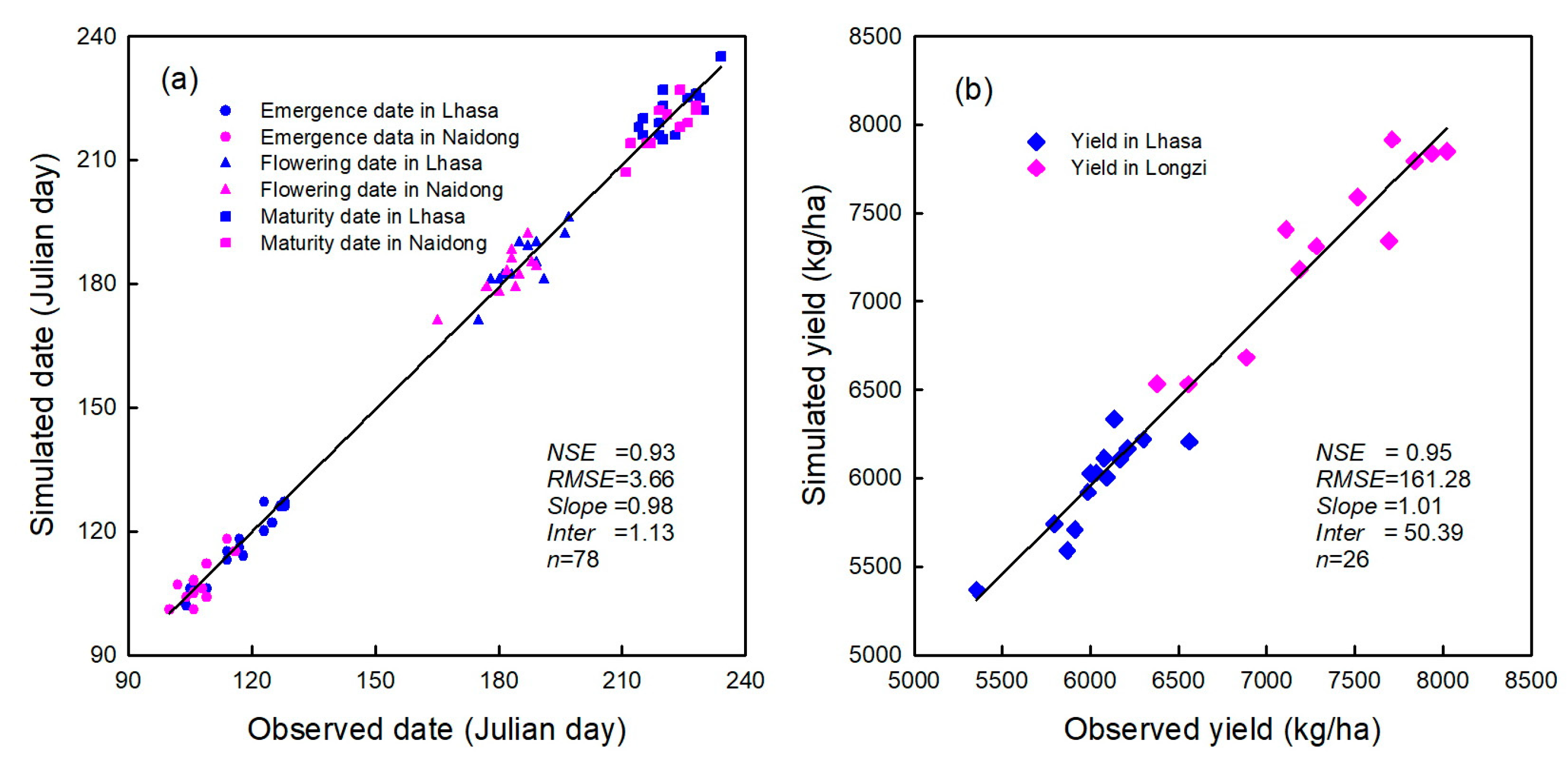


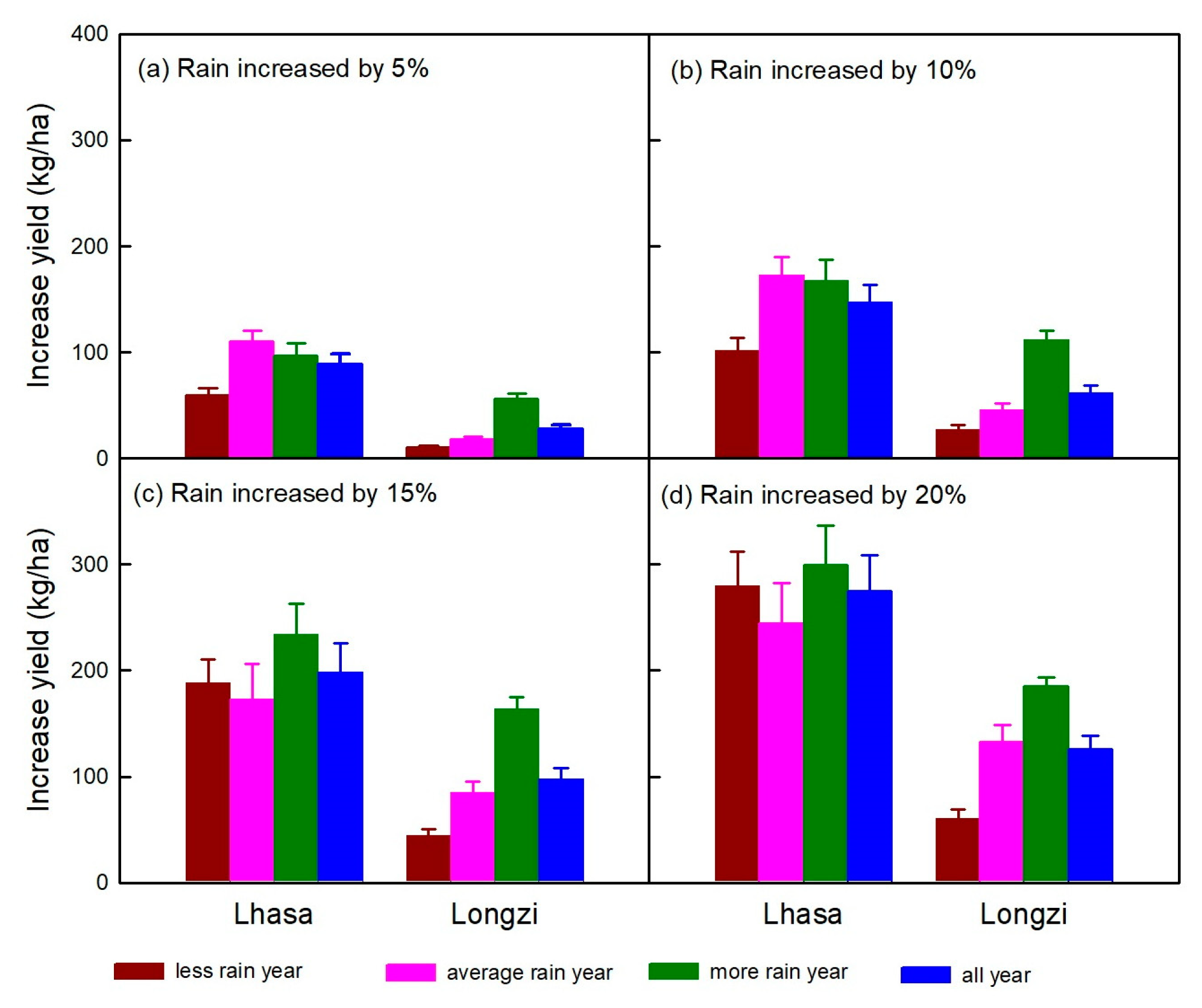
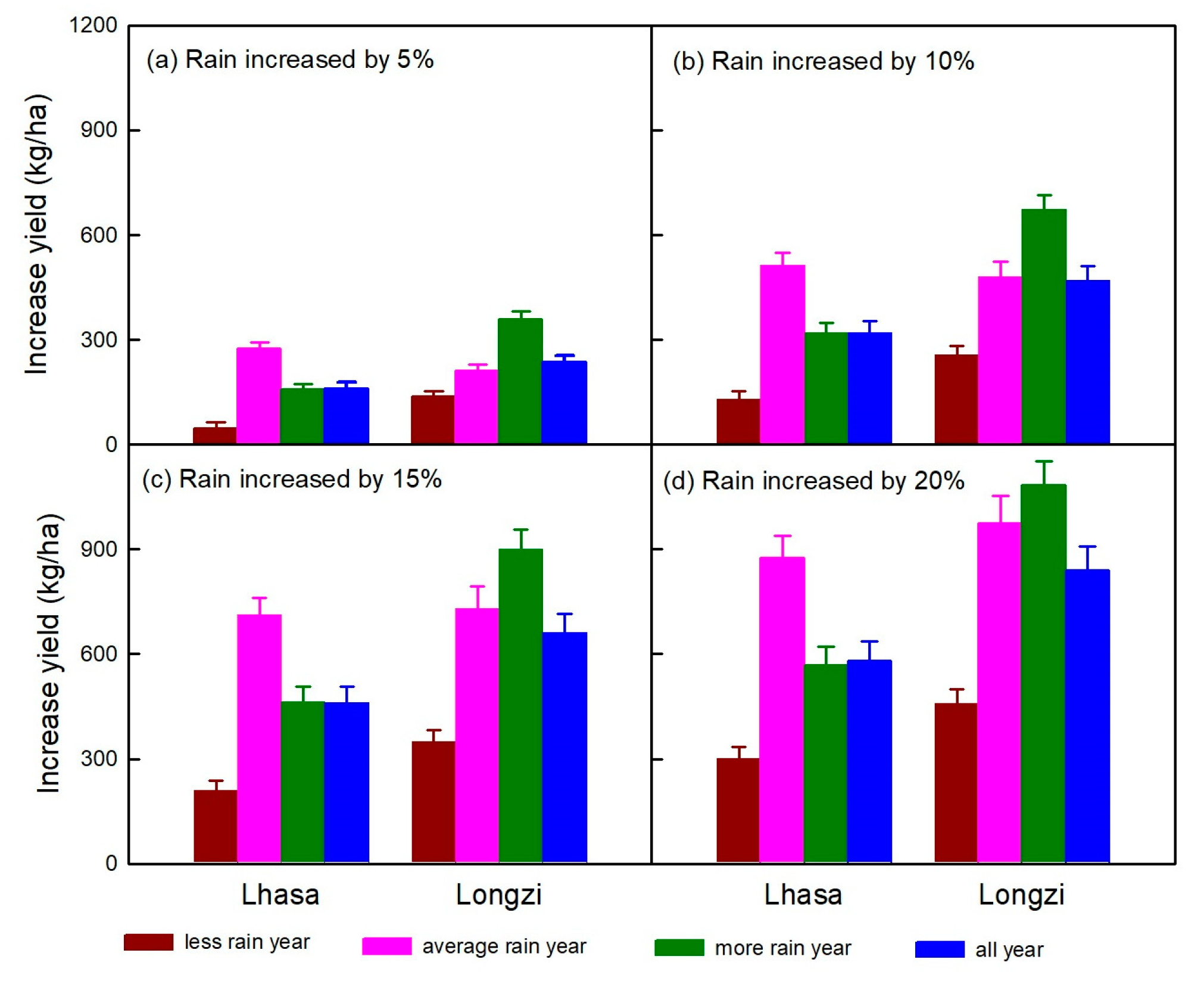
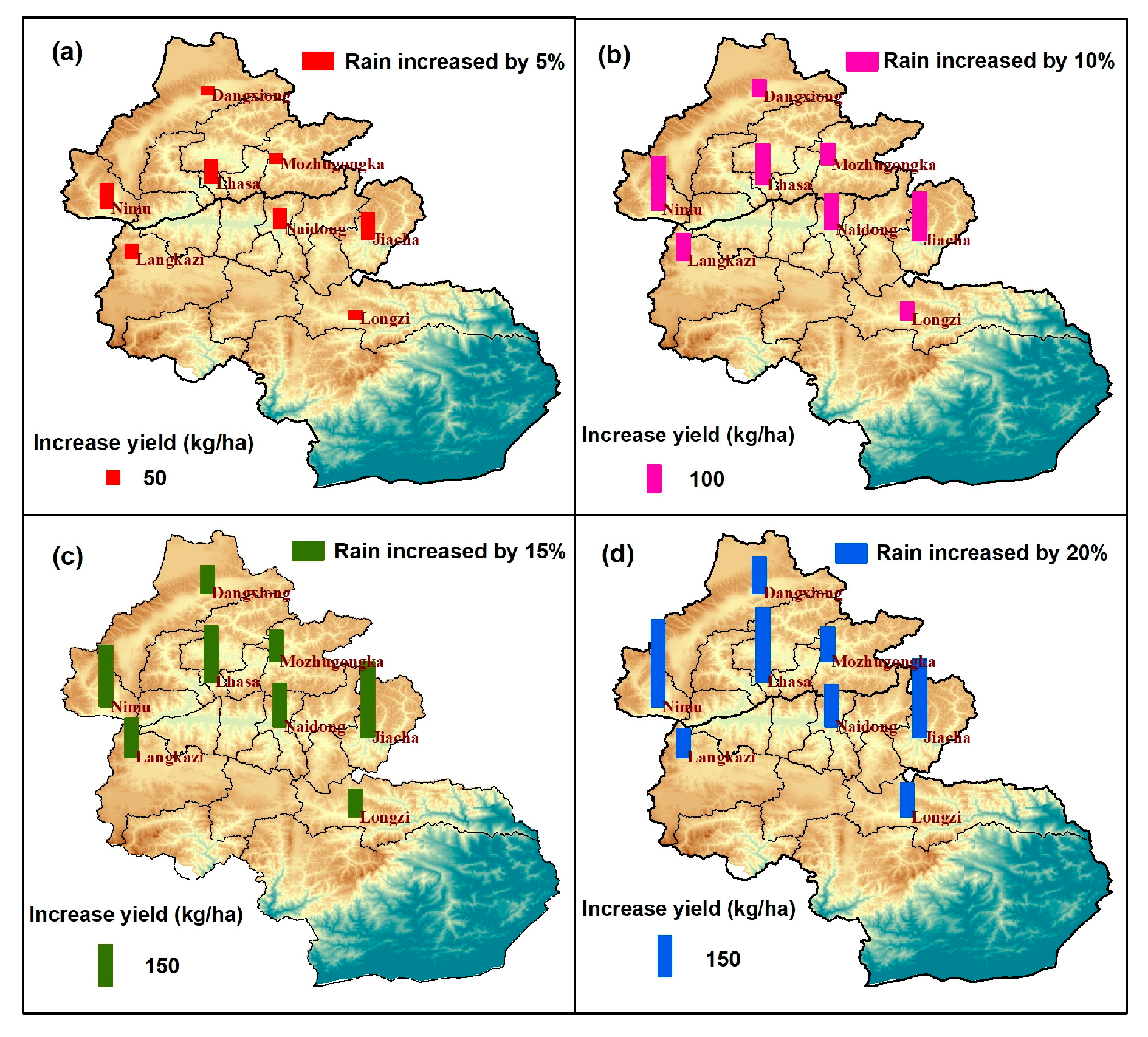
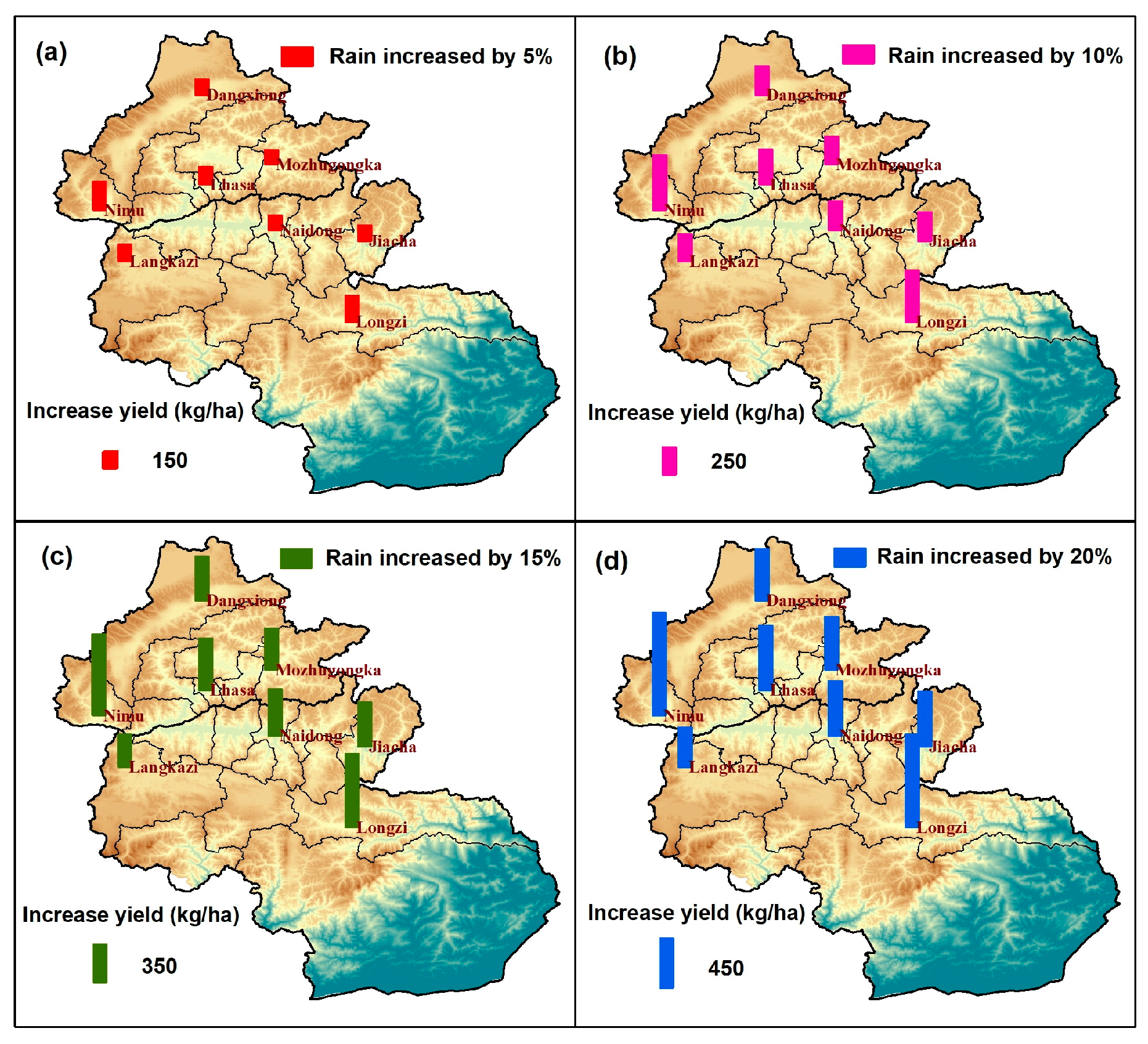





| Station | Latitude/N | Longitude/E | Altitude/m | Precipitation in Growth Period/mm |
|---|---|---|---|---|
| Dangxiong | 30.483 | 91.100 | 4200.0 | 382.2 |
| Jiacha | 29.150 | 92.583 | 3260.0 | 378.1 |
| Langkazi | 28.967 | 90.400 | 4431.7 | 312.2 |
| Lhasa | 29.667 | 91.133 | 3648.9 | 376.3 |
| Longzi | 28.417 | 92.467 | 3860.0 | 241.8 |
| Mozhugongka | 29.850 | 91.733 | 3804.0 | 432.1 |
| Naidong | 29.250 | 91.767 | 3551.7 | 332.0 |
| Nimu | 29.433 | 90.167 | 3809.4 | 291.1 |
| Model No. | Name of GCM | Abbreviation of GCM | Institute | Country |
|---|---|---|---|---|
| 1 | ACCESS-CM2 | ACC1 | ACCESS | Australia |
| 2 | ACCESS-ESM1-5 | ACC2 | ACCESS | Australia |
| 3 | BBC-CSM2-MR | BCCC | BCC, CMA | China |
| 4 | CanESM5 | Can1 | CCCMA | Canada |
| 5 | CMCC-CM2-SR5 | CMCS | CMCC | Italy |
| 6 | CNRM-ESM2-1 | CNR1 | CNRM-CERFACS | France |
| 7 | CNRM-CM6-1 | CNR2 | CNRM-CERFACS | France |
| 8 | EC-Earth3 | ECE1 | EC-Earth Consortium | Europe |
| 9 | FGOALS-g3 | FGOA | IAP, CAS | China |
| 10 | GFDL-CM4 | GFD1 | GFDL | USA |
| 11 | GFDL-ESM4 | GFD2 | GFDL | USA |
| 12 | GISS-E2-1-G | GISS | NASA-GISS | USA |
| 13 | HadGEM3-GC31-LL | HadG | MOHC | UK |
| 14 | INM-CM4-8 | INM1 | INM | Russia |
| 15 | INM-CM5-0 | INM2 | INM | Russia |
| 16 | IPSL-CM6A-LR | IPSL | IPSL | France |
| 17 | MIROC6 | MIR1 | MIROC | Japan |
| 18 | MIROC-ES2L | MIR2 | MIROC | Japan |
| 19 | MPI-ESM1-2-HR | MPI1 | MPI | Germany |
| 20 | MPI-ESM1-2-LR | MPI2 | MPI | Germany |
| 21 | MRI-ESM2-0 | MTIE | MRI | Japan |
| 22 | UKESM1-0-LL | UKES | MOHC | UK |
| Station | Annual SPEI | SPEI in the Growth Periods | ||||
|---|---|---|---|---|---|---|
| Trend | Z Value | Hurst Value | Trend | Z Value | Hurst Value | |
| Dangxiong | −0.019 | −1.196 | 0.705 | 0.007 | 0.285 | 0.613 |
| Jiacha | −0.032 | −2.212 | 0.685 | −0.020 | −1.285 | 0.677 |
| Langkazi | −0.021 | −1.500 | 0.651 | −0.007 | −0.393 | 0.626 |
| Lhasa | −0.025 | −1.945 | 0.632 | −0.002 | −0.250 | 0.608 |
| Longzi | 0.000 | 0.001 | 0.528 | 0.002 | 0.071 | 0.612 |
| Mozhugongka | −0.022 | −1.213 | 0.653 | −0.010 | −0.464 | 0.661 |
| Naidong | −0.015 | −1.499 | 0.659 | 0.008 | 0.428 | 0.584 |
| Nimu | −0.055 | −3.104 | 0.716 | −0.040 | −2.355 | 0.680 |
Disclaimer/Publisher’s Note: The statements, opinions and data contained in all publications are solely those of the individual author(s) and contributor(s) and not of MDPI and/or the editor(s). MDPI and/or the editor(s) disclaim responsibility for any injury to people or property resulting from any ideas, methods, instructions or products referred to in the content. |
© 2025 by the authors. Licensee MDPI, Basel, Switzerland. This article is an open access article distributed under the terms and conditions of the Creative Commons Attribution (CC BY) license (https://creativecommons.org/licenses/by/4.0/).
Share and Cite
Liu, J.; Wang, F.; Liu, D.L.; Du, J.; Wu, R.; Ding, H.; Sun, F.; Yu, Q. Beneficial Analysis of the Effect of Precipitation Enhancement on Highland Barley Production on the Tibetan Plateau Under Different Climate Conditions. Climate 2025, 13, 83. https://doi.org/10.3390/cli13050083
Liu J, Wang F, Liu DL, Du J, Wu R, Ding H, Sun F, Yu Q. Beneficial Analysis of the Effect of Precipitation Enhancement on Highland Barley Production on the Tibetan Plateau Under Different Climate Conditions. Climate. 2025; 13(5):83. https://doi.org/10.3390/cli13050083
Chicago/Turabian StyleLiu, Jiandong, Fei Wang, De Li Liu, Jun Du, Rihan Wu, Han Ding, Fengbin Sun, and Qiang Yu. 2025. "Beneficial Analysis of the Effect of Precipitation Enhancement on Highland Barley Production on the Tibetan Plateau Under Different Climate Conditions" Climate 13, no. 5: 83. https://doi.org/10.3390/cli13050083
APA StyleLiu, J., Wang, F., Liu, D. L., Du, J., Wu, R., Ding, H., Sun, F., & Yu, Q. (2025). Beneficial Analysis of the Effect of Precipitation Enhancement on Highland Barley Production on the Tibetan Plateau Under Different Climate Conditions. Climate, 13(5), 83. https://doi.org/10.3390/cli13050083







